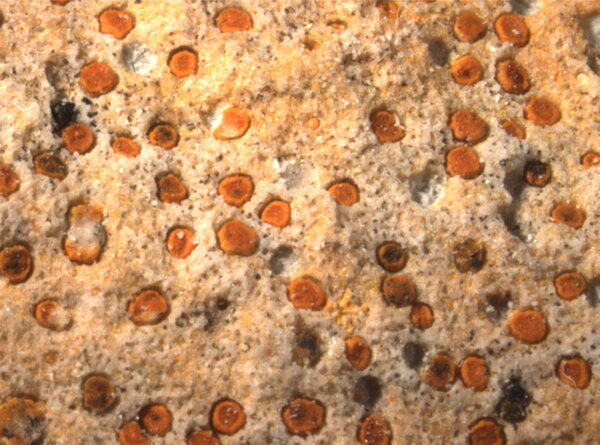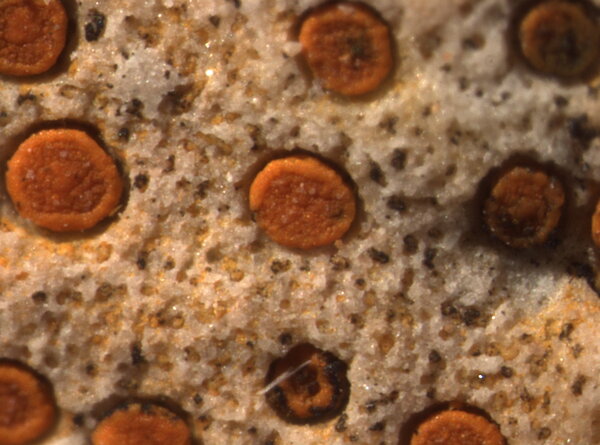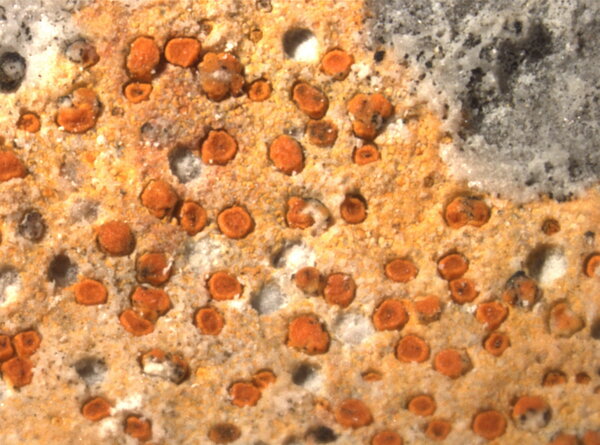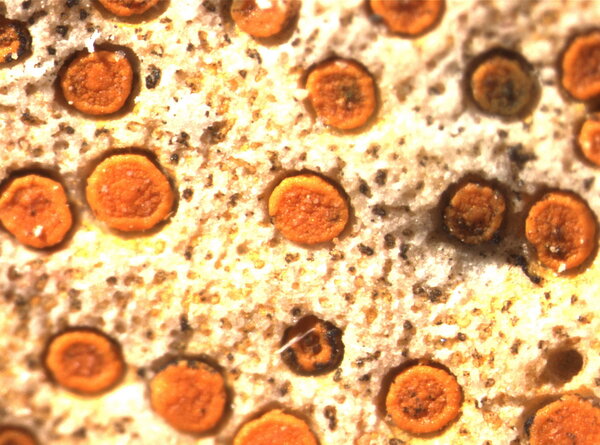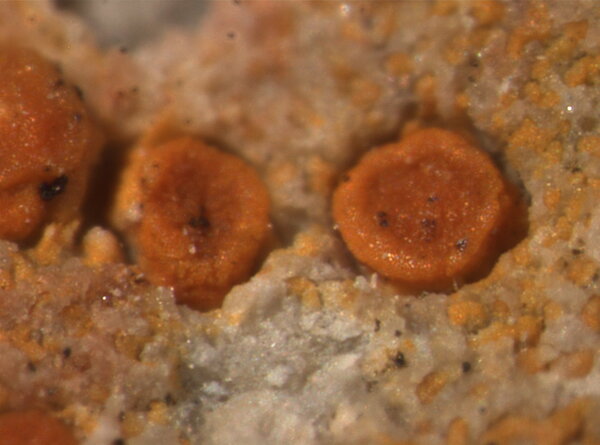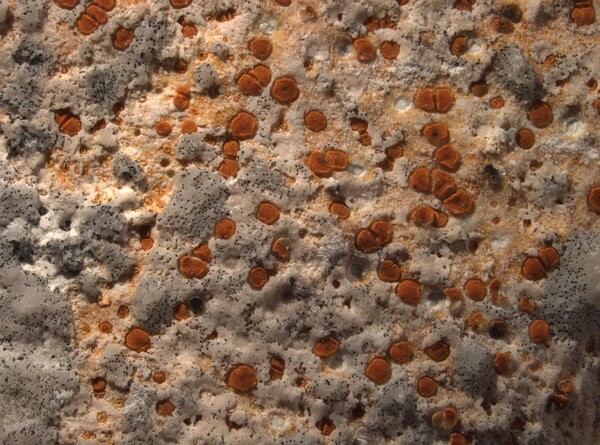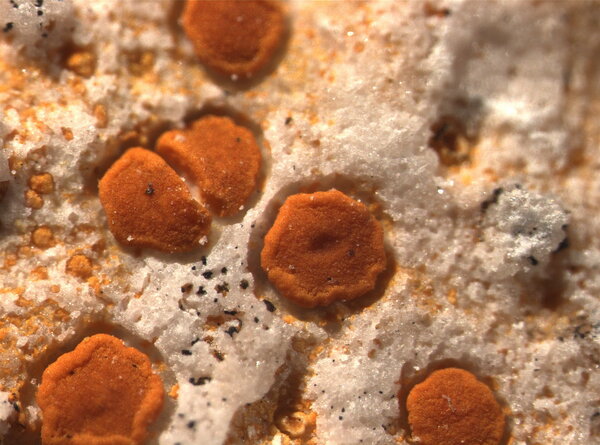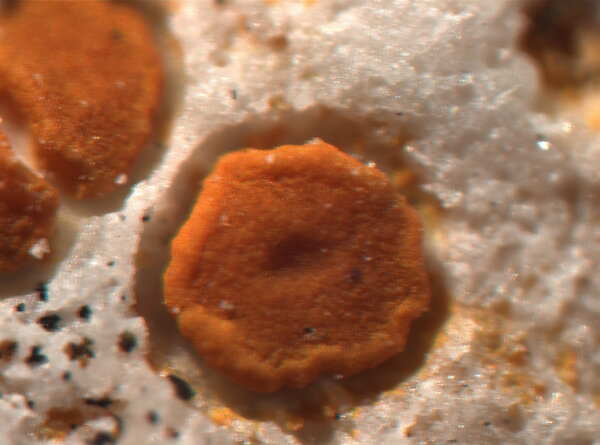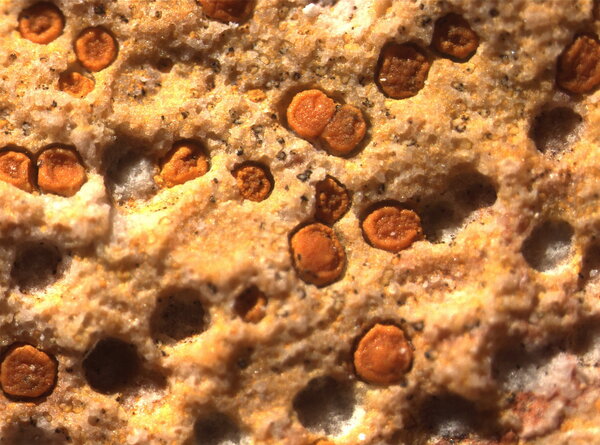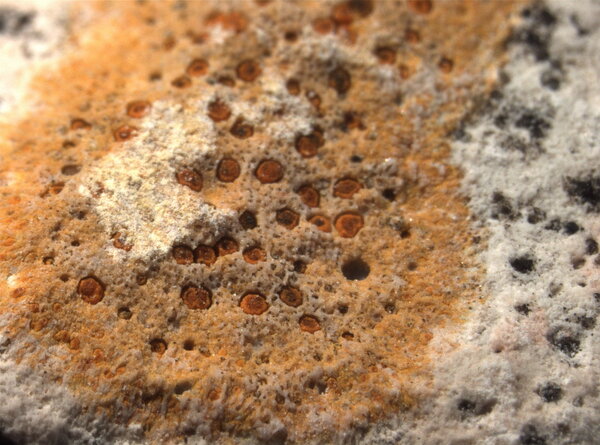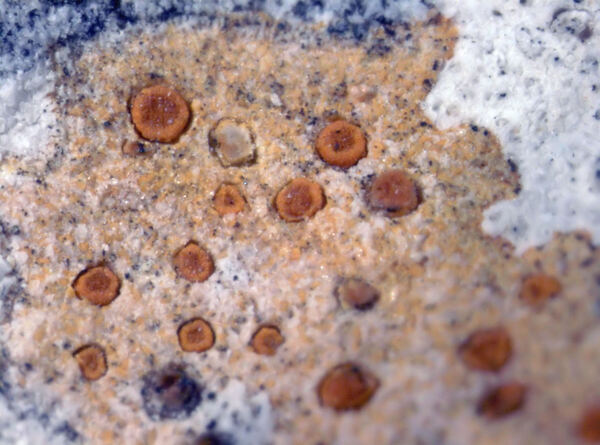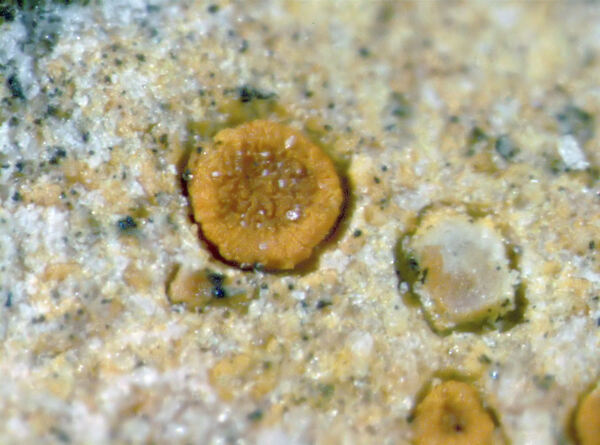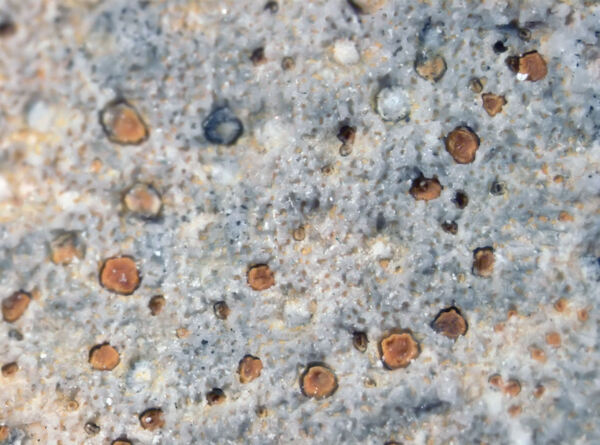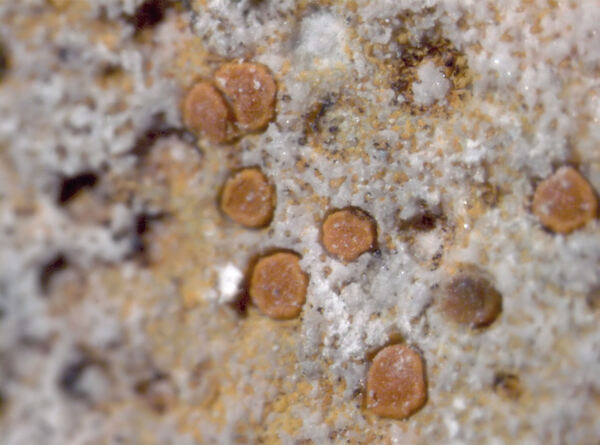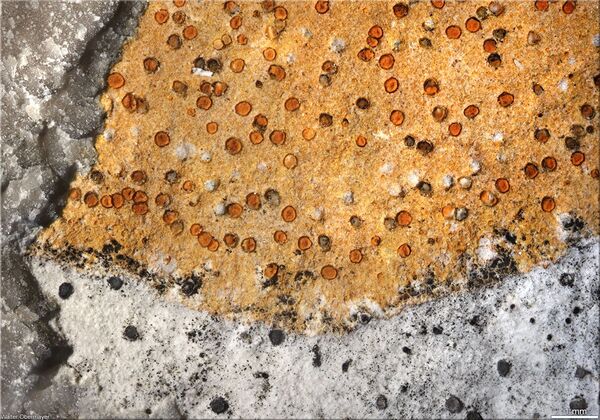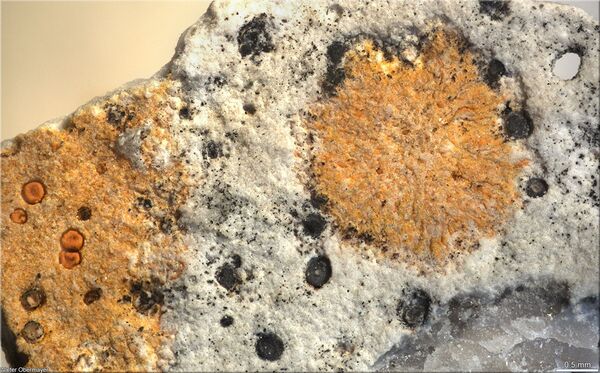Caloplaca nubigena (Kremp.) Dalla Torre & Sarnth.
Die Flechten von Tirol: 184, 1902. Basionym: Callopisma ochraceum var. nubigenum Kremp. - Denkschr. bot. Ges. Regensurg, 4, 2: 163, 1861.
Synonyms: Blastenia nubigena (Kremp.) Müll. Arg.; Caloplaca nubigena (Kremp.) Dalla Torre & Sarnth. var. nubigena
Distribution: N - Frl, Ven (Tomaselli & al. 2006), TAA (Nascimbene & al. 2022). C - Marc (Nimis & Tretiach 1999), Laz (Nimis & Tretiach 2004), Abr (Recchia & Villa 1996, Nimis & Tretiach 1999), Mol (TSB 32589).
Description: Thallus crustose, endosubstratic or very thinly episubstratic, ochraceous orange to orange, continuous in endolithic forms to granular-rimose in epilithic forms, forming well-delimited, more or less orbicular patches, sometimes delimited by a thin pale prothallus, developing on the thalli of Clauzadea immersa. Apothecia pseudolecanorine, 0.2-0.5(-1) mm across, at least at the beginning immersed in pits of the rocks or (in epilithic forms) immersed in the thallus, later subsessile, with a dark orange, usually flat disc, and a slightly paler, often finally excluded proper margin, without a thalline margin. Proper exciple paraplectenchymatous, c. 140 µm wide, with a few algae at the base; epithecium orange-brown, K+ purple-red; hymenium colourless, 70-100 µm high; paraphyses mostly simple, with swollen, up to 7 µm wide apical cells; hypothecium colourless, rather indistinct, prosoplectenchymatous. Asci 8-spored, clavate, functionally unitunicate, apically thickened with a broad internal beak, the inner part of apex and external cap I+ blue, Teloschistes-type. Ascospores 2-celled, polarilocular, hyaline, ellipsoid, 9-13(-15) x (3-)5-7 µm, the equatorial thickening (“septum”) 2.5-4(-5) µm. Photobiont chlorococcoid. Spot tests: thallus and apothecia K+ purple-red, C-, KC-, P-. Chemistry: thallus and apothecia with unidentified anthraquinones. Note: on calcareous rocks in upland areas, often near summits. Similar to C. coccinea, but differing in morphology, thallus colour, altitudinal distribution (not restricted to above treeline) and in its parasitism on Clauzadea immersa. See also note on C. keissleri.
Growth form: Crustose endolithic
Substrata: rocks
Photobiont: green algae other than Trentepohlia
Reproductive strategy: mainly sexual
paras Clauzadea immersa
Commonnes-rarity: (info)
Alpine belt: rather rare
Subalpine belt: rather rare
Oromediterranean belt: very rare
Montane belt: extremely rare
Submediterranean belt: absent
Padanian area: absent
Humid submediterranean belt: absent
Humid mediterranean belt: absent
Dry mediterranean belt: absent
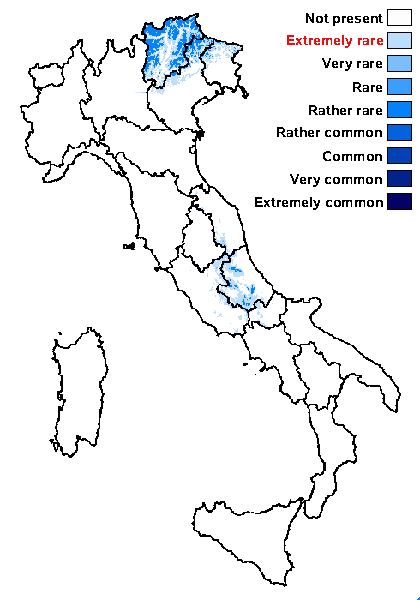
Predictive model
Herbarium samples


Elena Pittao; Owner: Derpartment of Life Sciences, University of Trieste CC BY-SA 4.0
Herbarium: TSB (23792)
02/02/2017
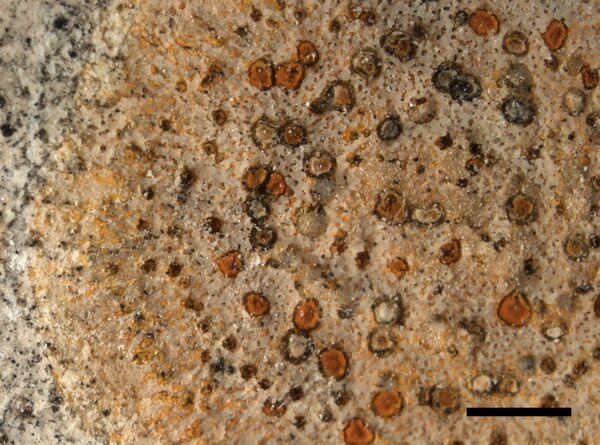

Elena Pittao; Owner: Derpartment of Life Sciences, University of Trieste CC BY-SA 4.0
Herbarium: TSB (23792)
02/02/2017
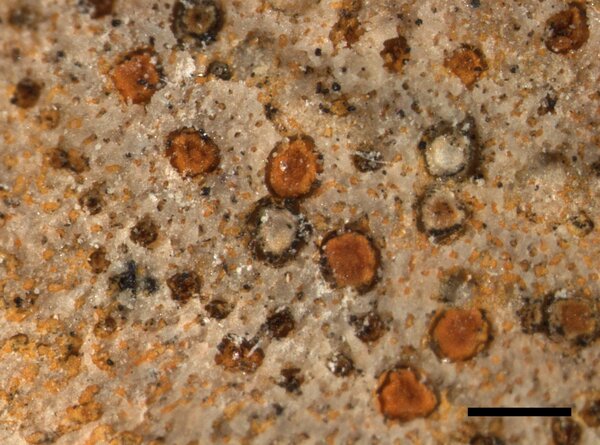

Elena Pittao; Owner: Derpartment of Life Sciences, University of Trieste CC BY-SA 4.0
Herbarium: TSB (23792)
02/02/2017
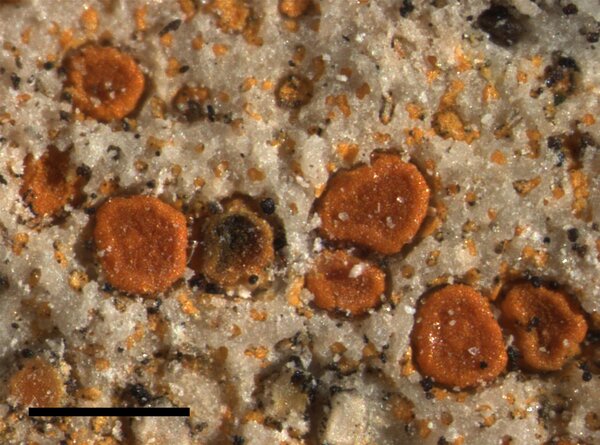

Elena Pittao; Owner: Derpartment of Life Sciences, University of Trieste CC BY-SA 4.0
Herbarium: TSB (23792)
02/02/2017

Felix Schumm - CC BY-SA 4.0
[BR5030040195379], France, Alpes Maritimes, Enclave de la Brigue, roches calcaires, 2180 m. Leg. E. Jacques (6636), 29.07.1968.
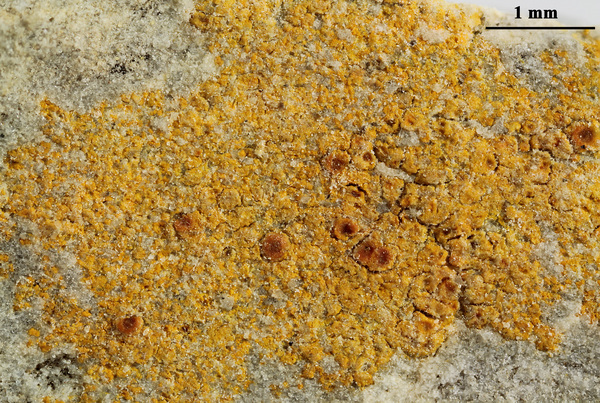
Felix Schumm - CC BY-SA 4.0
[BR5030040195379], France, Alpes Maritimes, Enclave de la Brigue, roches calcaires, 2180 m. Leg. E. Jacques (6636), 29.07.1968.

Felix Schumm - CC BY-SA 4.0
[BR5030040195379], France, Alpes Maritimes, Enclave de la Brigue, roches calcaires, 2180 m. Leg. E. Jacques (6636), 29.07.1968.

Felix Schumm - CC BY-SA 4.0
[BR5030040195379], France, Alpes Maritimes, Enclave de la Brigue, roches calcaires, 2180 m. Leg. E. Jacques (6636), 29.07.1968.
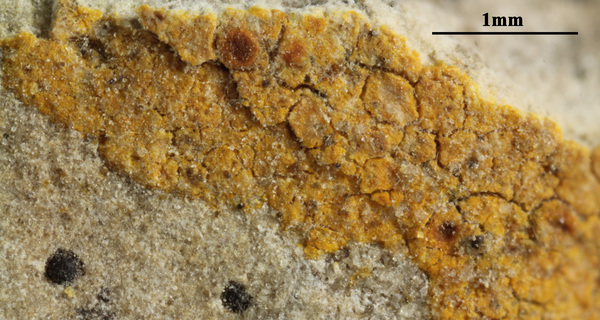
Felix Schumm - CC BY-SA 4.0
[BR5030040195379], France, Alpes Maritimes, Enclave de la Brigue, roches calcaires, 2180 m. Leg. E. Jacques (6636), 29.07.1968.
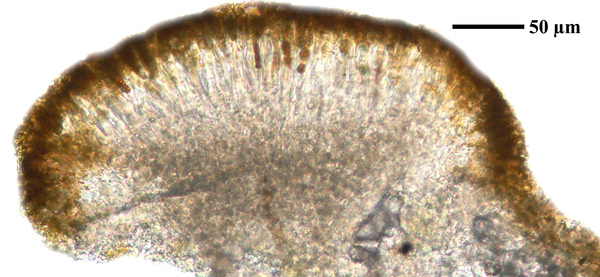
Felix Schumm - CC BY-SA 4.0
[BR5030040195379], France, Alpes Maritimes, Enclave de la Brigue, roches calcaires, 2180 m. Leg. E. Jacques (6636), 29.07.1968.

Felix Schumm - CC BY-SA 4.0
[BR5030040195379], France, Alpes Maritimes, Enclave de la Brigue, roches calcaires, 2180 m. Leg. E. Jacques (6636), 29.07.1968.
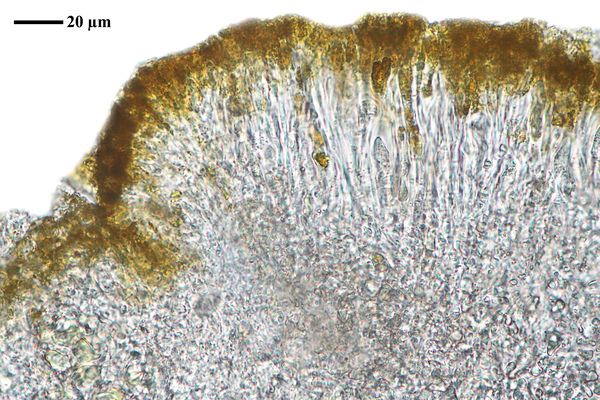
Felix Schumm - CC BY-SA 4.0
[BR5030040195379], France, Alpes Maritimes, Enclave de la Brigue, roches calcaires, 2180 m. Leg. E. Jacques (6636), 29.07.1968.
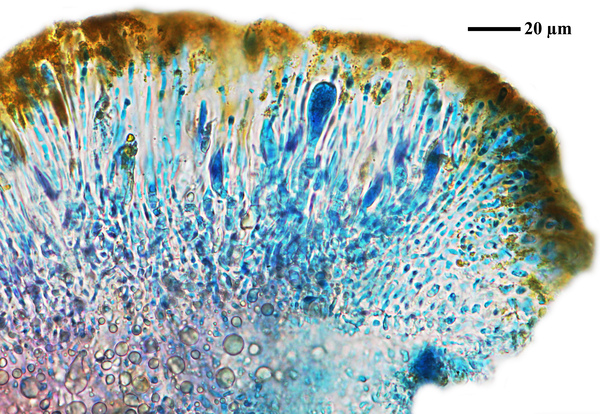
Felix Schumm - CC BY-SA 4.0
[BR5030040195379], France, Alpes Maritimes, Enclave de la Brigue, roches calcaires, 2180 m. Leg. E. Jacques (6636), 29.07.1968.
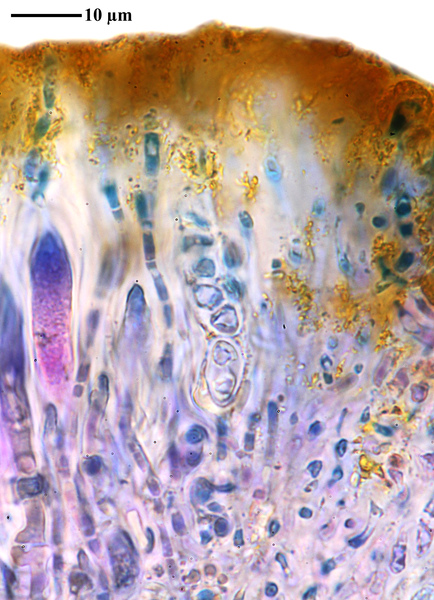
Felix Schumm - CC BY-SA 4.0
[BR5030040195379], France, Alpes Maritimes, Enclave de la Brigue, roches calcaires, 2180 m. Leg. E. Jacques (6636), 29.07.1968.
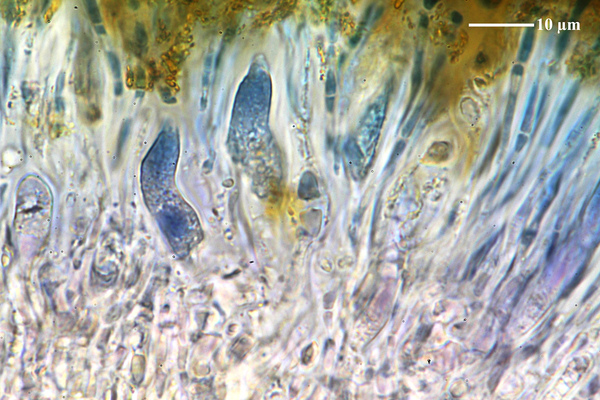
Felix Schumm - CC BY-SA 4.0
[BR5030040195379], France, Alpes Maritimes, Enclave de la Brigue, roches calcaires, 2180 m. Leg. E. Jacques (6636), 29.07.1968.

Felix Schumm - CC BY-SA 4.0
[BR5030040196383], Yugoslavia, Montenegro, 1500 m. Leg. et det. M. Servit 1929.
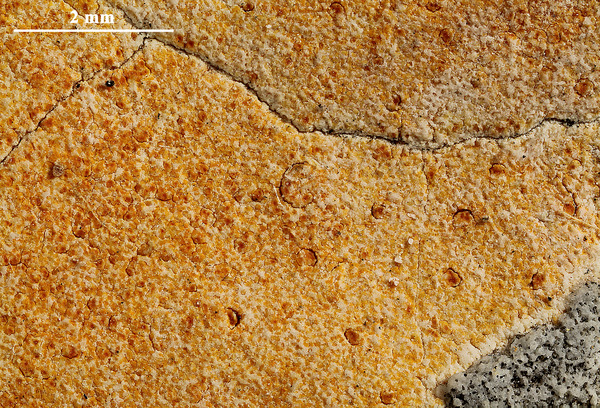
Felix Schumm - CC BY-SA 4.0
[BR5030040196383], Yugoslavia, Montenegro, 1500 m. Leg. et det. M. Servit 1929.
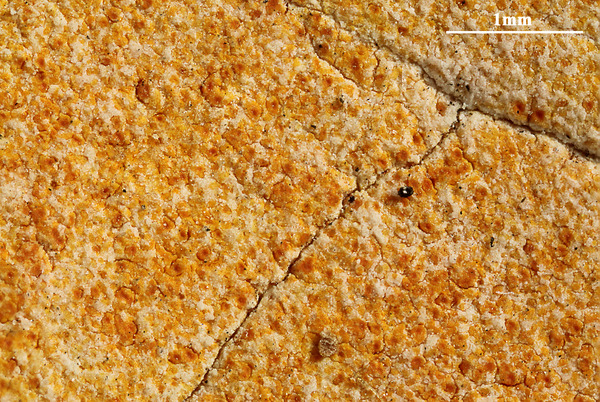
Felix Schumm - CC BY-SA 4.0
[BR5030040196383], Yugoslavia, Montenegro, 1500 m. Leg. et det. M. Servit 1929.

Felix Schumm - CC BY-SA 4.0
[BR5030040196383], Yugoslavia, Montenegro, 1500 m. Leg. et det. M. Servit 1929.
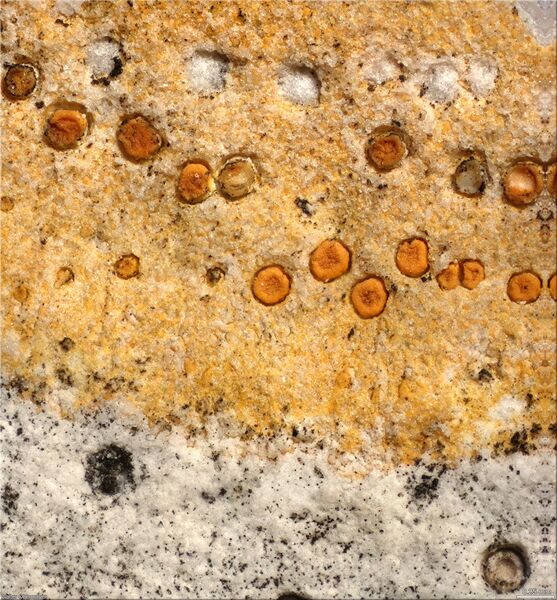
Walter Obermayer CC BY-SA 4.0 - Source: Lichens of Noricum - http://lichens-of-noricum.uni-graz.at/
Austria
Hafellner 67597
Growth form: Crustose endolithic
Substrata: rocks
Photobiont: green algae other than Trentepohlia
Reproductive strategy: mainly sexual
paras Clauzadea immersa
Commonnes-rarity: (info)
Alpine belt: rather rare
Subalpine belt: rather rare
Oromediterranean belt: very rare
Montane belt: extremely rare
Submediterranean belt: absent
Padanian area: absent
Humid submediterranean belt: absent
Humid mediterranean belt: absent
Dry mediterranean belt: absent

Predictive model
| Herbarium samples |


Elena Pittao; Owner: Derpartment of Life Sciences, University of Trieste CC BY-SA 4.0
Herbarium: TSB (23792)
02/02/2017


Elena Pittao; Owner: Derpartment of Life Sciences, University of Trieste CC BY-SA 4.0
Herbarium: TSB (23792)
02/02/2017


Elena Pittao; Owner: Derpartment of Life Sciences, University of Trieste CC BY-SA 4.0
Herbarium: TSB (23792)
02/02/2017


Elena Pittao; Owner: Derpartment of Life Sciences, University of Trieste CC BY-SA 4.0
Herbarium: TSB (23792)
02/02/2017

Felix Schumm - CC BY-SA 4.0
[BR5030040195379], France, Alpes Maritimes, Enclave de la Brigue, roches calcaires, 2180 m. Leg. E. Jacques (6636), 29.07.1968.

Felix Schumm - CC BY-SA 4.0
[BR5030040195379], France, Alpes Maritimes, Enclave de la Brigue, roches calcaires, 2180 m. Leg. E. Jacques (6636), 29.07.1968.

Felix Schumm - CC BY-SA 4.0
[BR5030040195379], France, Alpes Maritimes, Enclave de la Brigue, roches calcaires, 2180 m. Leg. E. Jacques (6636), 29.07.1968.

Felix Schumm - CC BY-SA 4.0
[BR5030040195379], France, Alpes Maritimes, Enclave de la Brigue, roches calcaires, 2180 m. Leg. E. Jacques (6636), 29.07.1968.

Felix Schumm - CC BY-SA 4.0
[BR5030040195379], France, Alpes Maritimes, Enclave de la Brigue, roches calcaires, 2180 m. Leg. E. Jacques (6636), 29.07.1968.

Felix Schumm - CC BY-SA 4.0
[BR5030040195379], France, Alpes Maritimes, Enclave de la Brigue, roches calcaires, 2180 m. Leg. E. Jacques (6636), 29.07.1968.

Felix Schumm - CC BY-SA 4.0
[BR5030040195379], France, Alpes Maritimes, Enclave de la Brigue, roches calcaires, 2180 m. Leg. E. Jacques (6636), 29.07.1968.

Felix Schumm - CC BY-SA 4.0
[BR5030040195379], France, Alpes Maritimes, Enclave de la Brigue, roches calcaires, 2180 m. Leg. E. Jacques (6636), 29.07.1968.

Felix Schumm - CC BY-SA 4.0
[BR5030040195379], France, Alpes Maritimes, Enclave de la Brigue, roches calcaires, 2180 m. Leg. E. Jacques (6636), 29.07.1968.

Felix Schumm - CC BY-SA 4.0
[BR5030040195379], France, Alpes Maritimes, Enclave de la Brigue, roches calcaires, 2180 m. Leg. E. Jacques (6636), 29.07.1968.

Felix Schumm - CC BY-SA 4.0
[BR5030040195379], France, Alpes Maritimes, Enclave de la Brigue, roches calcaires, 2180 m. Leg. E. Jacques (6636), 29.07.1968.

Felix Schumm - CC BY-SA 4.0
[BR5030040196383], Yugoslavia, Montenegro, 1500 m. Leg. et det. M. Servit 1929.

Felix Schumm - CC BY-SA 4.0
[BR5030040196383], Yugoslavia, Montenegro, 1500 m. Leg. et det. M. Servit 1929.

Felix Schumm - CC BY-SA 4.0
[BR5030040196383], Yugoslavia, Montenegro, 1500 m. Leg. et det. M. Servit 1929.

Felix Schumm - CC BY-SA 4.0
[BR5030040196383], Yugoslavia, Montenegro, 1500 m. Leg. et det. M. Servit 1929.

 INDEX FUNGORUM
INDEX FUNGORUM
 GBIF
GBIF
 DOLICHENS
DOLICHENS
